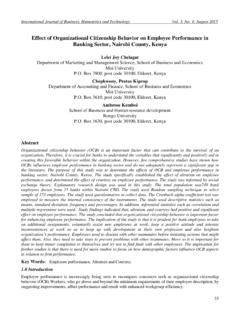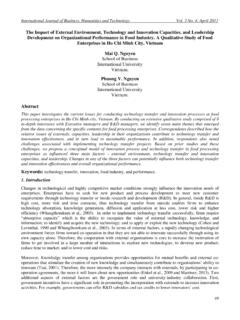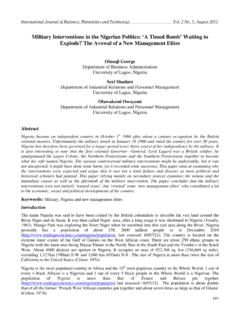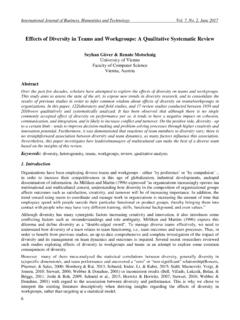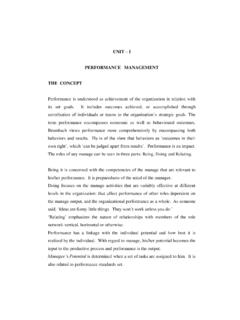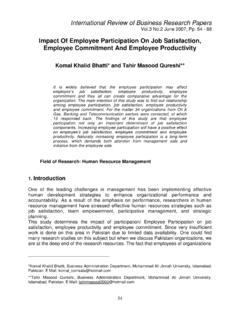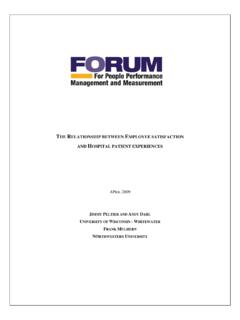Transcription of Relationship among Managerial Support, Job Satisfaction ...
1 International Journal of Business, Humanities and Technology Vol. 2 No. 5; August 2012 179 Relationship among Managerial Support, Job Satisfaction and Organizational Commitment: A Comparative Study of Nonprofit, For-Profit and Public Sectors in Turkey Abdurrahim Emhan, Assistant Professor of Business Dicle University Faculty of Economics and Administration Department of Business 21280, Diyarbak r, Turkey Abstract This is a comparative study that investigates relationships among Managerial support, job Satisfaction , and organizational commitment in nonprofit, for-profit, and public organizations. It is based on a survey with a target sample of 750 employees working in education and health organizations in the three sectors in Turkey; 614 returns were valid for use as data in the research. The data analysis revealed that there are positive relationships between Managerial support and job Satisfaction , and between both these variables and two components of organizational commitment but not a third, and that these relationships differ between the three sectors.
2 Key words: nonprofit, Managerial support, job Satisfaction , organizational commitment. Introduction The purpose of this study was to investigate the relationships between Managerial support, job Satisfaction and organizational commitment of salaried employees in nonprofit organizations compared with those working in the public and for-profit sectors. There have been many studies that aim to investigate these relationships in each sector separately, but few comparing the three sectors in a single research project. This study is the first to do so in Turkey. It both contributes to the literature and provides valuable information for administrators working in the nonprofit, sector. The theoretical framework of the study is social exchange theory, first proposed by Homans (1958). The basic assumption of this theory is that organizations receive positive contributions from their employees in exchange for providing benefits to their employees.
3 In other words, the more the organization treats its employees well the more the employees respond well and care about the organization. In particular, the commitment of employees to their organization increases as a result of Managerial support and job Satisfaction . This theory has been used in many studies of organizational commitment (Stevens et al., 1978; Eisenberger et al., 2002; Gagnon et al., 2004; Martin et al., 2005). The present study sought to answer the following questions: 1. Are there any relationships between Managerial support, job Satisfaction , and components of organizational commitment? 2. Are there any differences among employees working in nonprofit, for-profit, and public organizations in terms of Managerial support, job Satisfaction , and components of organizational commitment? Nonprofit Entrepreneurial Organizations In western societies, there is a long history of nonprofit organizations, often churches and their sub-organizations, seeking to serve the public (Maxwell, 2007).
4 In Turkey, public services were provided by Ahi organizations, which were a kind of job or trade association, tradesmen s guilds and foundations, ( imen and G ven, 2007; Gemici, 2010). Many foundations and associations offering services in numerous areas except for public security have existed since the time of Ottoman and even Seljukian. In the Ottoman period, these organizations services included mosques, caravansaries, khans, drinking water supply, protecting widows and orphans, providing dowries for poor and orphaned girls, and helping debtors and indigent people. Foundations that developed during the Ottoman Empire continued to contribute to social life when the Turkish Republic was established in the 1920s (Ural, 1995). Centre for Promoting Ideas, USA 180 Today, Turkish nonprofit organizations operate in the areas of social services, education and research, health, art and culture, protecting children and the elderly, environment protection, social security and religious services (Oster, 1995; Warda, 2004).
5 They play important roles in society in terms of their human resources and financial powers (Salamon and Anheier, 1996; Haris, 2010). In the literature, they are variously called nonprofit, voluntary, charitable, philanthropic, third sector, tax-exempt and independent organizations, and Non Publical Organizations (NGOs) and they are commonly understood to serve society without pursuing commercial objectives (Benett and Dilorenzo, 1989; Salamon and Anheir, 1997; Drucker, 2002). However, the roles of these types of organizations have changed in the last two decades (Schimid, 2004). In the past, nonprofit organizations were perceived as charitable organizations, whereas today they are coming to be seen as part of the industrial sector (Faruggia, 2007). This is because Turkish nonprofits, like those in many other countries, have become increasingly involved in commercial activities since the 1990s, beginning to act like for-profit organizations when their support from public became inadequate to improve and extend their services.
6 These kind of hybrids are known as commercial nonprofit and nonprofit entrepreneurial organizations, owning and operating for example fee-charging hospitals and schools (Young, 2001) in order to generate profits to devote to delivering better public services. In some cases they have merged or formed partnerships with for-profit organizations (McLauglin, 1998; O'Regan and Oster, 2000; Andreasen, 2001). Increasingly, these nonprofits look like commercial organizations. Their financial structure has fundamentally changed, with revenues from their commercial activities being higher than these coming from public (Weisbrod, 1998b). However, their profits or commercial revenues are not being shared with members and stakeholders; instead, these funds are being used to improve working conditions within the organizations and increase the public s social wellbeing (Glaeser and Shleifer, 2001).
7 The organizations are adopting for-profit practices: they conduct fund raising activities, seek to utilize their resources effectively, and try to find alternative ways to reduce heir expenses, all in order to survive and compete with for-profit organizations (Young, 2001; Faruggia, 2007). The managers of these commercial nonprofits are increasingly adopting professional management strategies, techniques and business rules to increase their organizations effectiveness (Oster, 1995). Moreover, there are undergraduate and graduate nonprofit management programs in many universities, and commercial nonprofits are hiring people with degrees from these programs in order to better manage their financial and human resources (Ott, 2001). Despite these convergences, the entrepreneurial nonprofit, for-profit and public sectors nevertheless comprise different types of organizations, especially in terms of their missions, objectives, working conditions, financial structure, and their attitude toward to employees (Weisbrod, 1998a; Boris, 2001; Nelson, 2001; Goulet and Frank, 2002).
8 The aim of this paper is to examine the extent to which these differences are manifest in terms of employees commitment to their employing organizations, and whether this commitment is differentially related to Managerial support and job Satisfaction across the three sectors. Organizational Commitment Organizations need commitment from their employees in order to reduce costs and improve performance, service and product quality. Therefore, organizational commitment is vital for both for-profit and nonprofit organizations. Such commitment is enhanced pragmatically by building trust, teamwork, and employee empowerment, methods that were often developed in the nonprofit sector but are now being increasingly effectively used in the for-profit sector (Daft, 2001).Organizations must invest in human resources and retain personnel in order to reach their objectives.
9 Research shows that employees with higher levels of commitment to their organizations objectives have better relations with coworkers, have higher levels of personal Satisfaction , lower levels of absenteeism and personnel turnover, and perform their jobs better than employees with lower level commitment (Bateman and Strasser, 1984; Suliman, 2002; Obeng and Ugboro, 2003). There are many definitions of organizational commitment, developed by scholars according to their interest area. In some studies it has been defined in terms of employees emotions and psychological characteristics (Kanter, 1968; Morrow et al., 1983; O Reilley, 1989); other studies focus on employees physical and moral expectations and define commitment in terms of employees personal objectives (Becker, 1960; Mowday and Steers, 1979; Wiener, 1982). International Journal of Business, Humanities and Technology Vol.
10 2 No. 5; August 2012 181 Instead of creatinga new definition, this study uses a definition developed by Allen and Meyer (1990) in which organizational commitment is considered in terms of employees perceptions and expectations of their organizations. In this approach, there are three components: affective, normative and continuance commitment. Employees with strong affective commitment stay in the organization because they desire to. Employees with a high level of normative commitment stay in the organization because they feel obliged to. Employees who have a high level of continuance commitment stay in the organization because they need to (Allen and Meyer, 1990). Affective commitment is a matter of employees embracing organizational objectives and values (Allen and Meyer, 1990). If the employee and organization share the same objectives, affective commitment increases and the employee become happier.


